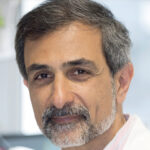Présentation
Stem cells are defined by their is their capacity for self-renewal and differentiation. Some adult tissues maintain a reservoir of stem cells, that generally reside within specialized microenvironments, known as stem cell niches, that regulate their behaviour. Skeletal muscle stem (satellite) cells are quiescent in homeostatic conditions in adults, and they are activated after muscle injury, when they re-enter the cell cycle, proliferate and differentiate into myoblasts, which will then fuse to form new muscle fibers.
Satellite cells express the paired/homeodomain gene Pax7, which plays a critical role in satellite cell maintenance postnatally. Numerous experiments have shown that the skeletal muscle stem cell population is heterogeneous, therefore like many other stem cell systems, characterising the stem cell states is a major objective.
In our laboratory, a reversible dormant cell state was identified, correspondent to a Pax7Hi quiescent subpopulation (top 10% of the Pax7-nGFP+ cells isolated from the transgenic mouse model Tg:Pax7-nGFP) with a lower metabolic activity and longer lag for the first cell division compared to Pax7Lo cells. Muscle stem cells that survive for extended periods post-mortem are also dormant, suggesting that this property, in addition to anoxia contributes to their viability. Therefore, different physiological states are associated with distinct cell states of muscle stem cells.
Metabolism could play a critical role in dictating whether a cell remains quiescent, proliferates or differentiates. Stem cell metabolic plasticity in homeostasis and differentiation, as well as during cell reprogramming, is well described in different cell systems. However, unanswered questions remain regarding the metabolic regulation of satellite cell biology and skeletal muscle regeneration.
In this project, we will investigate the behaviour of muscle stem cells in distinct physiological states, especially post-mortem and aging.

